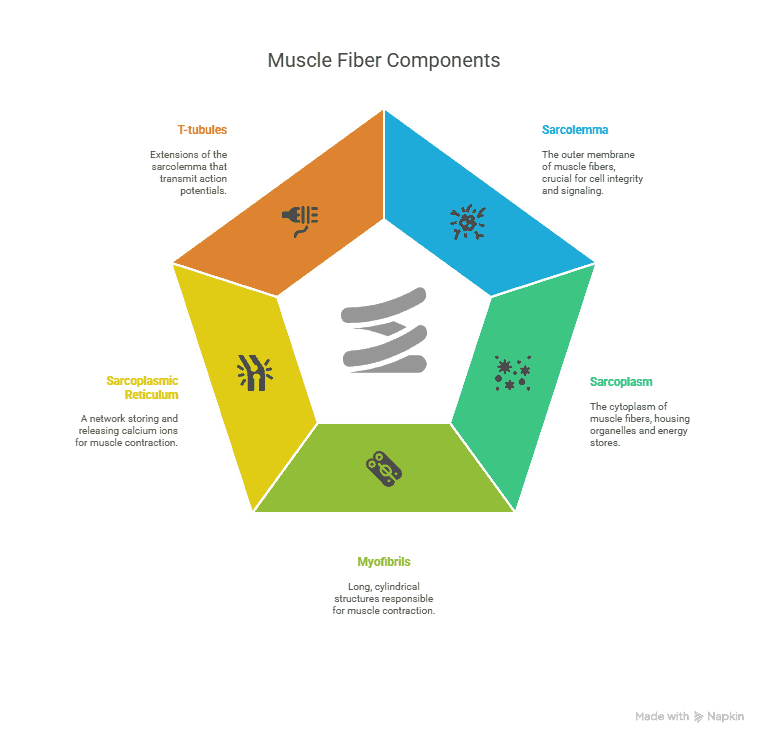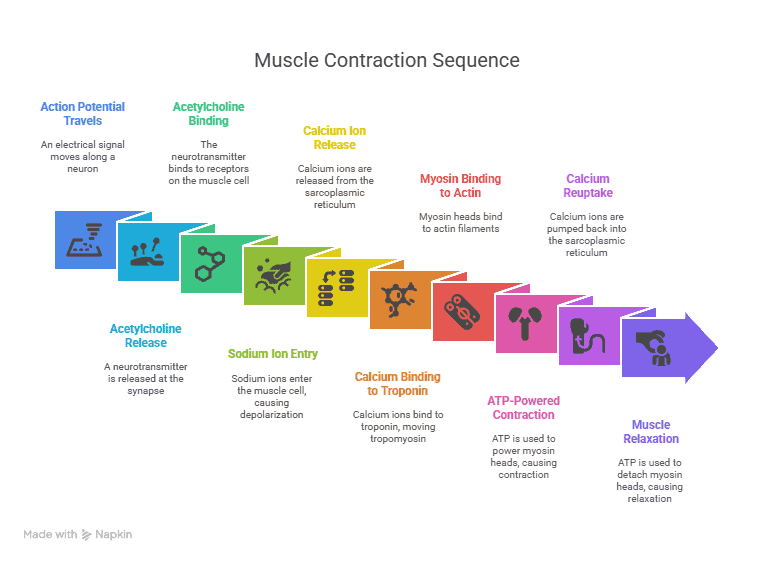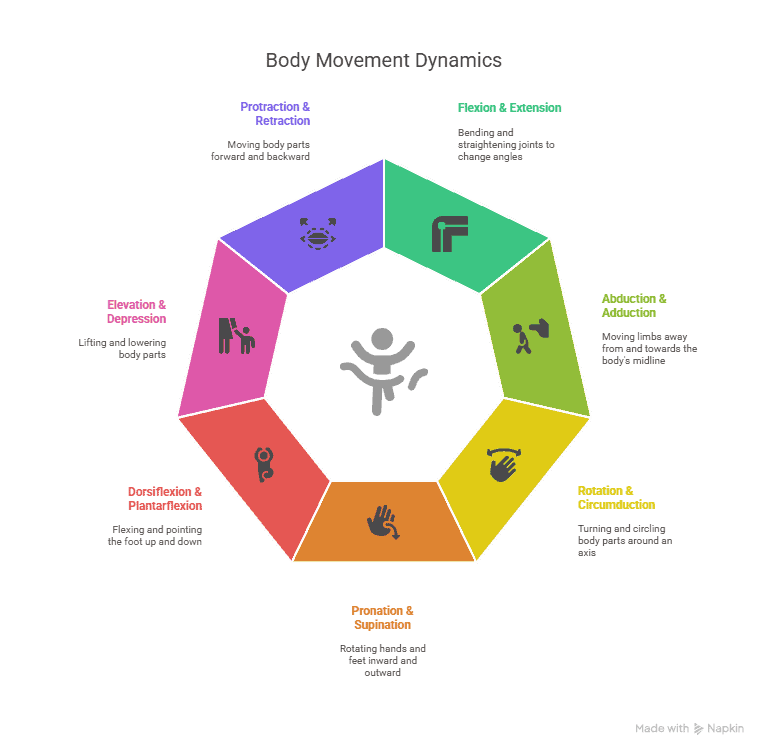Welcome to the Muscular System learning module! In this module, you will learn all about the muscles in your body and how they work together to help you move and stay strong. Muscles are an essential part of your anatomy, and understanding how they function can help you stay healthy and active. Let’s dive in and explore the fantastic world of the muscular system!
Objectives:
- Learn about the different types of muscles in the body
- Understand how muscles work with bones to create movement
- Identify the major muscles in the body and their functions
Section 1: What is the Muscular System?
The Muscular System is made up of muscles that work together to help our bodies move. Muscles are like rubber bands that contract and relax to make our bones move. There are three types of muscles: skeletal muscles, which help us move our arms and legs; smooth muscles, which control functions such as digestion; and cardiac muscles, which regulate the heartbeat.
Muscles are attached to bones by tendons, which are like strong ropes. When we exercise, our muscles get stronger and can do more work.
Muscle Anatomy
Types of Muscles
This section will cover the three main types of muscles: skeletal, smooth, and cardiac, explaining their functions and locations in the body.
| Type of Muscle | Definition |
|---|---|
| Skeletal Muscle | Voluntary muscles that are attached to bones and help with movement. |
| Cardiac Muscle | Involuntary muscles found in the heart that help pump blood throughout the body. |
| Smooth Muscle | Involuntary muscles found in internal organs and blood vessels that help with movements like digestion and blood flow. |
Games and Activities
Muscle Fiber Structure
There are three main types of muscles in the human body: skeletal, smooth, and cardiac. Skeletal muscles are the ones we can control and are attached to our bones, allowing us to move.s
Smooth muscles are found in our internal organs and play a crucial role in functions such as digestion and breathing. Cardiac muscles are unique to the heart and are responsible for pumping blood throughout the body.
Each type of muscle has its unique structure and function, but they all work together to help us move and maintain our health.

| Muscle Fiber Structure | Definition |
|---|---|
| Sarcolemma | The cytoplasm of a muscle fiber contains organelles such as mitochondria and myofibrils, as well as glycogen for energy storage. |
| Sarcoplasm | Transverse tubules are extensions of the sarcolemma and allow for the rapid transmission of action potentials deep into the muscle fiber. |
| Myofibrils | Long, cylindrical structures within muscle fibers that contain contractile proteins called actin and myosin, which are responsible for muscle contraction. |
| Sarcoplasmic reticulum | A network of tubules surrounding myofibrils that stores and releases calcium ions, which are essential for muscle contraction. |
| T-tubules | Transverse tubules are extensions of the sarcolemma, allowing for the rapid transmission of action potentials deep within the muscle fiber. |
Games and Activities
Motor Unit and Neuromuscular Junction
Motor units and neuromuscular junctions work together to make our muscles move. Motor units are groups of muscle fibers controlled by a single nerve. When our brain sends a signal to move a muscle, the nerve releases a chemical called acetylcholine at the neuromuscular junction.
Acetylcholine tells the muscle to contract. This initiates a chain reaction that causes the muscle fibers to contract and move. Therefore, without acetylcholine, our muscles would be unable to contract and move.
Section 2: Muscle Function
Muscle Contraction Process
Muscle contraction is a complex process that involves several steps. It all starts with a signal from the brain that travels down the nerves and reaches the muscle.

Steps of a Muscle Contraction
- An action potential travels down a motor neuron
- Acetylcholine is released from the motor neuron
- Acetylcholine binds to receptors on the muscle cell membrane
- Sodium ions enter the muscle cell, causing depolarization
- Calcium ions are released from the sarcoplasmic reticulum
- Calcium binds to troponin, causing tropomyosin to move
- Myosin heads bind to actin filaments
- ATP is used to power myosin heads, causing muscle contraction
- Calcium is pumped back into the sarcoplasmic reticulum
- Muscle relaxes as ATP is used to detach myosin heads from actin filaments.
Muscle Energy Metabolism
Muscle energy metabolism refers to the process by which our muscles generate energy to move and function properly. When we eat food, our bodies break it down into glucose, which is a type of sugar. Our muscles use this glucose to produce a molecule called ATP, which is like a small battery that provides us with energy.
When we exercise, our muscles use up this ATP to help us move. If we don’t have enough glucose or oxygen, our muscles can become tired and cramp. Pre-med students need to understand muscle energy metabolism, as it helps them comprehend how their bodies function and how they can maintain their health.
Muscle Actions and Movements
Muscle actions and movements are essential to understand in the study of the human body. Muscles work by contracting and relaxing, allowing us to move our bodies in various ways.

| Muscle Action | Definition |
|---|---|
| Flexion | Movement that decreases the angle between two body parts, typically bending a joint. |
| Extension | Movement that increases the angle between two body parts, typically straightening a joint. |
| Abduction | Movement away from the midline of the body. |
| Adduction | Movement towards the midline of the body. |
| Rotation | Movement around an axis, typically referring to the twisting motion of a joint. |
| Circumduction | A combination of flexion, extension, abduction, and adduction creating a circular movement at a joint. |
| Elevation | Movement that raises body parts, such as shrugging the shoulders. |
| Depression | Movement that lowers body parts, such as lowering the shoulders from a shrug. |
Games and Activities
Section 3: Muscle Disorders
Common Muscle Injuries
Common muscle injuries include strains, sprains, and tears. Strains occur when muscles are stretched too far or overused. Sprains happen when ligaments are stretched or torn. Tears occur when muscle fibers are damaged.
Symptoms of these injuries include pain, swelling, and limited movement. Treatment options may include rest, ice, compression, and elevation (RICE method), as well as physical therapy and pain medications. It’s essential to seek medical attention if the injury is severe or if symptoms persist or worsen.
Neuromuscular Disorders
Neuromuscular disorders are conditions that affect the nerves that control the muscles in the human body. Three common neuromuscular disorders are muscular dystrophy, myasthenia gravis, and ALS. Muscular dystrophy causes weakness and loss of muscle mass, myasthenia gravis leads to muscle weakness and fatigue, and ALS affects the nerve cells that control muscle movement.
These disorders can impact a person’s ability to move, breathe, and even swallow. Treatment options for these disorders vary, but may include medications, physical therapy, and in some cases, surgery. Pre-med students need to comprehend these disorders and their effects on muscle function, enabling them to deliver the most effective care to patients in the future.
Muscle Disorders in Sports Medicine
As a pre-med student, it’s essential to understand how muscle disorders can affect athletes. Overuse injuries, such as tendinitis or stress fractures, can occur when muscles are subjected to repetitive strain without enough time to rest and recover. Muscle cramps, on the other hand, can be caused by dehydration, electrolyte imbalances, or poor conditioning.
To prevent muscle disorders, athletes should focus on proper warm-up and cool-down routines, maintain good hydration levels, and incorporate strength training and flexibility exercises into their training regimen. If a muscle disorder does occur, rehabilitation strategies may include rest, ice, compression, and elevation, as well as physical therapy to help strengthen and repair the affected muscles.
Conclusion
Great job! You’ve completed the learning module on the Muscular System. Throughout this module, you’ve learned about the following objectives:
- The functions of muscles in the body
- The types of muscles (skeletal, smooth, and cardiac)
- How muscles work together to help us move and perform actions
- The importance of exercise in keeping our muscles strong and healthy
Remember to continue practicing what you’ve learned and stay active to maintain strong and healthy muscles.
What to Study Next?
It is a good idea to study the nervous system next. This system controls how we think, feel, and move. It works with the muscles to help us move and react to things around us. Learning about the nervous system will help you understand how your body communicates with your brain.
It is a critical system to be aware of because it helps us understand how our bodies work together. Take some time to research and learn about the nervous system to expand your knowledge of the human body.
